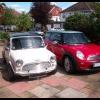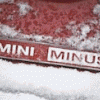The A-Series did well to eventually achieve 1275cc displacement in production bearing in mind it originally started life in 1952 as 803cc......but the high cost of the development of the A+ for the Metro (Total cost of A+ development and retooling programme: £30 million) has made little sense to me over the years for what was achieved, when the money spent could easily have produced a 5-speed gearbox upgrade for the Mini and Metro which were to be in production for many more years and with motorway driving by then an essential part of most drivers motoring needs.
Engines : A-Series:-
https://www.aronline...gines-a-series/
Interesting extract below from an AROnline 'Mini Development in the 1970's' article about BL's research into the OHC A-Series engine:-
"In April 1982 the Mini was given higher gearing to make it more economical, but this did nothing for acceleration, and the car lost a little of its buzzbox characteristics. The fact that the ancient A-Series engine could cope with up-gearing was a tribute to its remarkable torque characteristics, even in its tamest form.
And that brings us to the subject of why the A-Series engine was never radically re-engineered to modern standards. Was it a matter of cost or were there other reasons?
Back in the 1970s BL had embarked on projects to develop overhead camshaft versions of both the A- and B-Series engines. The reason for this was that MG used both engines and as they exported to the USA where stringent anti-emissions legislation was in force, it was paramount that BL’s existing engines were made more efficient to enable them to remain both legal and competitive by using the more efficient emissions friendly overhead cam layout.
In the end the OHC B-Series evolved into the O-Series engine first seen in 1978, while converting the A-Series to the overhead cam layout proved to be a technical cul-de-sac. The immediate problem of continuing to sell the MG Midget in the USA was solved by replacing the 1275cc A-Series engine with the 1493cc Triumph engine also used in the rival Spitfire. But an OHC A-Series could be used in the ADO88 and other BL cars. In the event eleven prototype overhead cam A-Series engines were built in 1975 using Cooper S blocks in capacities of 970cc, 1097cc and 1275cc. The engines used aluminium cylinder heads.
The engineers obtained the following performance figures for OHC Minis:
970cc: OHC 59bhp @ 6750rpm, 51lb ft @ 5250rpm
1097cc: OHC 72bhp @ 6500rpm, 64lb ft @ 5000rpm
1275cc: OHC 84bhp @ 6750rpm, 80lb ft @ 4500rpm
The above figures look very impressive, and a bluff-fronted Mini Clubman fitted with the OHC 1275cc engine and twin HS6 SU carburettors could reach 100mph. It would be easy to accuse BL of another missed opportunity. But a look at the comparative figures for the existing overhead valve engines reveal another story. For a direct comparison first we will use the three Cooper S engines and then the standard tune single carburettor engines seen in the mainstream production Minis.
Standard OHV Mini engines:
970cc: OHV 65bhp @ 6500rpm, 55lb ft @ 3500rpm
1071cc: OHV 70bhp @ 6000rpm, 62lb ft @ 4500rpm
1275cc: OHV 76bhp @ 5800rpm, 80lb ft @ 3000rpm
998cc: OHV 38bhp @ 5250rpm, 52lb ft @ 2700rpm
1098cc: OHV 45bhp @ 5250rpm, 56lb ft @ 2700rpm
1275cc: OHV 54bhp @ 5250rpm, 67lb ft @ 2500rpm
Converting the A-Series engine to overhead camshaft simply pushed the peak torque further up the rev range and actually caused more problems than it solved. One of the great virtues of driving a Mini is its remarkable ability to pull top gear at low revs, something that was exploited by Austin Rover and later Rover when the car was up geared.
An overhead cam A-Series engine would have been torque shy where it mattered in everyday driving and that was indeed the case with the 100mph OHC Mini Clubman. The modern solution for the lack of torque where it matters would be to add more gear ratios, but BL’s engineers decided that a reliable revised transmission in sump gearbox was not feasible. Therefore the decision was taken to opt for the A+ programme. BL had already burnt its fingers with the OHC E-Series engine. The E-Series had been intended to supplant the B-Series, but its lack of torque resulted in the old B-Series going into the Marina and Princess, and even the O-Series was a disappointment. BL would not make the same mistake again."
http://www.aronline....history-part-2/
Let's operate from the premise the Mini, Metro and others did merit a 5-speed gearbox to better take advantage of the production A-OHC engine, either via the Issigonis in-sump layout (by way of Jack Knight's work on the experimental 5-speed being approved - plus 5-speed AP Automatic project between Jack Knight and Keith Gerrard of Bushey) or the now universal end-on layout.
A 1372-1380cc version of the 84 hp 1275cc A-OHC would approximately put out about 90 hp.
Where things get a bit confusing would be how to extrapolate how much more a hypothetical 1372-1380cc A-OHC was capable of putting out above 90 hp in naturally aspirated form against the following:
- The 1275cc MPi engine with factory-approved 1999 Si pack (Tpi) by John Cooper was putting out 90 hp
- The 1275 A+ Turbo about 94 hp (allegedly detuned from 120-130 hp to preserve gearbox in MG Metro Turbo)
- An MG-badged Authi Victoria ADO16 prototype featuring a 1275cc twin-carb engine putting out 83 hp or only a shade short of the 84 hp in the 1275 A-OHC
With the existing in-sump gearbox it is possible a 1372-1380cc A-Plus or A-OHC would remove the need for turbocharging in more potent versions of both the Mini and Metro, even if some modification and de-tuning would still likely be needed.
With a 5-speed gearbox (be it an in-sump or end-on layout), would roughly guesstimate turbocharged versions of the 1372-1380cc A-Plus or A-OHC being a match for the 118 hp Renault 5 1.4 GT Turbo and 118 hp Fiat Uno 1.4 Turbo. Which IIRC is said to be about the limit of the standard 1275cc naturally aspirated engine before further modification is needed (seen others put figure between 110-115 hp and 130 hp) despite reading of experimental MG Metro Turbos reaching 130 hp (unless the Metro Turbo engine was significantly strengthened compared to the existing 1275cc engine for the 120 hp limit to be less of an issue).
Outside of the Mini and Metro it is inevitable the 1372-1380cc in whatever iteration would be detuned in order to not encroach on the territory of bigger engines in other models such as the 1.7 O Series. 1.5 E Series (itself capable of 83 hp via Downton tuning) and 1.6 R / S Series, putting out anywhere from above 60-64 hp to below 76-80 hp depending on the model in question.
Edited by Mite, 30 August 2020 - 07:14 PM.



















